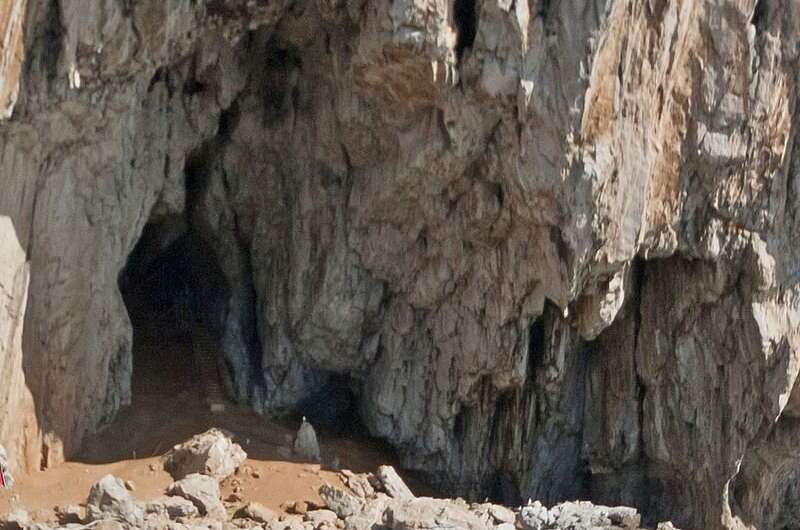Hidden chamber found in Vanguard Cave – part of Gorham's Cave Complex in Gibraltar

A team of researchers with the Gibraltar National Museum has found a hidden chamber in one of the caves that make up Gorham's Cave Complex in Gibraltar. They have posted a press statement on their website describing what they have found in the chamber thus far.
Prior research has shown that both modern humans and Neanderthals lived in parts of Gorham's Cave Complex in Gibraltar, though not at the same time. Both groups left behind a treasure trove of artifacts, including tools, butchered remains of animals and fossils. For that reason, the site has been designated as a UNESCO World Heritage Site. In 2012, a team at the Gibraltar National Museum studied the caves. As part of that mission, they sought chambers they believed were hidden in the caves. Such chambers are common in caves formed close to the sea due to environmental factors. Over the course of nearly a decade, the search for hidden chambers came up empty. Then, as one group was searching the back of Vanguard Cave, they found evidence of soft sediment, which they believed could be hiding a chamber. Some digging proved their hunch to be correct; behind the sediment plug, they found a large chamber.
The chamber was located higher up than the cave and was approximately 13 meters long. The amount of sediment in the plug suggested that the chamber had been sealed for tens of thousands of years. On its floor, they found the remains of a Griffon vulture, a hyena and a lynx, animals fully capable of climbing up into the chamber. But they also found the shell of a dog whelk—a type of sea snail, which the researchers note would not have been able to climb up into the chamber. This, they note, suggests something carried it up there. The team also found scratches on the walls of the chamber, though they were unable to discover their source.
Initial estimates suggest Neanderthals likely were living in the area during the time the chamber was open, though the researchers have not yet found any evidence. They plan to begin digging in the chamber floor to see what other evidence might be found.
More information: www.gibmuseum.gi/news/recent-d … at-vanguard-cave-335
© 2021 Science X Network
Griffon vulture - Wikipedia The griffon vulture (Gyps fulvus) is a large Old World vulture in the bird of prey family Accipitridae. It is also known as the Eurasian griffon. It is not to be confused with a different species, Rüppell's griffon vulture (Gyps rueppellii). It is closely related to the white-backed vulture (Gyps africanus).
The dog whelk, dogwhelk, or Atlantic dogwinkle (scientific name Nucella lapillus) is a species of predatory sea snail, a carnivorous marine gastropod in the family Muricidae, the rock snails.
Nucella lapillus was originally described by Carl Linnaeus in his landmark 1758 10th edition of Systema Naturae as Buccinum lapillus (the basionym).
By Jeevan Ravindran, CNN 1 day ago

The discovery of a chamber at least 40,000 years old in a Gibraltar cave previously inhabited by Neanderthals could lead to groundbreaking new finds about their lifestyles, according to researchers.
Archaeologists from the Gibraltar National Museum have been working since 2012 to find potential chambers and passages blocked by sediment in Vanguard Cave -- part of the UNESCO World Heritage site Gorham's Cave Complex.
Last month, they found the 13-meter (42-foot) deep chamber at the back of the cave, along with a number of discoveries including lynx, hyaena and griffon vulture remains, as well as scratch marks on the walls made by an unidentified carnivore.
Clive Finlayson, director and chief scientist at the Gibraltar National Museum, told CNN Tuesday the most impressive find was perhaps a large whelk, or a marine mollusc, because it suggested the newly discovered parts of the cave had been inhabited by Neanderthals.
"The whelk is at the back of that cave... it's probably about 20 meters from the beach," he said. "Somebody took that whelk in there... over 40,000 years ago. So that's already given me a hint that people have been in there, which is not perhaps too surprising. Those people, because of the age, can only be Neanderthals."
Neanderthals, heavily built Stone Age hominins that disappeared about 40,000 years ago, lived in Europe long before Homo sapiens arrived.
Finlayson said the team had also found the milk tooth of a Neanderthal around 4 years old, and hypothesized that they could have been dragged into the cave by a hyaena.
Entering the cave for the first time gave Finlayson "goosebumps," he said, adding it was one of the most exciting discoveries of his career -- unique for the quality of the preservation and the possibilities of new information it presented.
"How many times in your life are you going to find something that nobody's been into for 40,000 years? It only comes once in your lifetime, I think."
Evidence of an earthquake around 4,000 years ago was also visible due to a change in ice formations, with a previously formed ice curtain cut off and stalagmites growing under it.
The discovery is only the first stage of a long excavation, and Finlayson told CNN the chamber was only the roof of the cave, with a great deal of work remaining to uncover the rest of it.
"As we dig, it's only going to get bigger and bigger and bigger," he said. "So the chances are we have an enormous cave there. And as we go down there may even be so passages. So it's extremely exciting."
Finlayson said the remaining work would take decades if not longer, and that he hoped to use technology to take DNA samples from the sediment and uncover more clues of Neanderthal lifestyles, including burial rituals -- and potentially find footprints too.


No comments:
Post a Comment